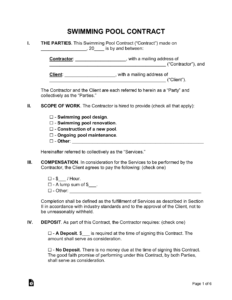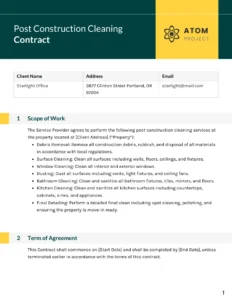Navigating the complexities of business agreements or even personal projects often brings up the thorny question of who is on the hook when things go wrong. Whether you are a service provider, a contractor, a landlord, or an event organizer, understanding and clearly defining liability for potential harm or loss is absolutely crucial for protecting your interests and fostering transparent relationships. Without explicit terms, disagreements can escalate quickly, leading to costly disputes and damaged reputations.
This is precisely where a clear and comprehensive contract comes into play. Having a robust agreement that meticulously outlines responsibilities and remedies can save you a world of headaches down the line. We’re talking about ensuring everyone involved knows exactly what to expect should an unfortunate incident occur. Let’s dive into how a well-structured responsible for damages contract template can be your best friend in creating legally sound and equitable arrangements.
Understanding the Core Elements of a Damages Clause
When you’re looking at a contract that deals with responsibility for damages, you’re essentially examining the blueprint for how problems will be addressed financially. This section of any agreement is designed to allocate risk and specify the consequences if one party’s actions, or lack thereof, lead to harm or loss for another. It’s not just about pointing fingers; it’s about providing a clear path to resolution and compensation.
Often, contracts differentiate between various types of damages. Direct damages are those that flow immediately and foreseeably from a breach, like the cost to repair a broken item. Consequential damages, however, are a bit trickier and arise indirectly from the breach, such as lost profits due to a delay caused by the other party. Understanding these distinctions is vital because the contract needs to specify which types of damages are recoverable and under what circumstances.
Another critical component is the limitation of liability. It’s common for contracts to include clauses that cap the maximum amount of damages one party can be held responsible for. This could be a fixed monetary amount or a percentage of the contract value. Such limitations are put in place to manage financial exposure and ensure that the risk is proportionate to the value of the agreement, preventing disproportionately large claims from bankrupting a party.
Indemnification clauses also frequently appear alongside damages provisions. While related, indemnification means one party agrees to compensate the other for losses or damages incurred by a third party. For example, if a contractor’s negligence causes injury to a third party on a client’s property, the contractor might indemnify the client against any lawsuits arising from that injury. This shifts the burden of defense and settlement to the indemnifying party.
Carefully drafting these sections is paramount. A poorly worded clause can leave significant loopholes or, conversely, create an unfair burden. This is where the power of a good template shines, guiding you to consider all necessary aspects.
Key Components to Look For in a Damages Clause
- Clear identification of the parties and their specific roles.
- The scope of liability, detailing what actions or inactions trigger responsibility.
- Precise definitions of “damage,” “loss,” or “harm” within the context of the agreement.
- Any agreed-upon limitations or caps on financial liability.
- Specific procedures for notifying a party of a claim for damages.
- Provisions for dispute resolution, such as mediation or arbitration.
- The governing law that will interpret the contract.
Practical Tips for Using and Customizing Your Template
While a responsible for damages contract template offers an excellent foundation, it’s crucial to remember that it’s a starting point, not a finished product for every situation. Each agreement is unique, and simply filling in the blanks without understanding the implications can lead to unexpected consequences. The real value comes from intelligently adapting the template to fit the specific nuances of your particular project or relationship.
Consider the industry you operate in. A construction contract will have vastly different damage considerations than a software development agreement or an event planning service. For instance, in construction, you might focus on delays, structural defects, or material failures, whereas in software, intellectual property infringement or data breaches might be higher on the list. Tailoring the template involves thinking through the specific risks inherent to your field.
Always involve legal counsel when customizing any significant contractual document. An attorney can help you navigate complex legal jargon, ensure compliance with local laws, and identify potential pitfalls you might overlook. They can also advise on the enforceability of specific clauses, such as limitations of liability, which can vary widely by jurisdiction. Relying solely on a generic template for high-stakes agreements is a risk that few can afford.
Furthermore, pay close attention to the language used. Avoid ambiguity at all costs. Every term should be clear, concise, and leave no room for multiple interpretations. If a clause is open to different meanings, it is almost guaranteed to become a point of contention should a dispute arise. Think about what specific scenarios could lead to damages and make sure your language explicitly covers or excludes those possibilities.
- Thoroughly review each clause to ensure it aligns with your specific needs and risk tolerance.
- Consult with legal professionals for guidance, especially for high-value or complex agreements.
- Ensure that the language used is unambiguous and easily understood by all parties.
- Consider incorporating specific examples of what constitutes a breach or damage within your context.
- Clearly define the process for assessing and claiming damages.
Having a well-crafted agreement, especially one that clearly spells out who is responsible for damages, is more than just a legal formality; it’s a testament to good planning and foresight. It establishes trust, minimizes misunderstandings, and provides a clear framework for resolution if things don’t go as planned. By taking the time to customize a solid template, you are investing in the stability and predictability of your ventures.
Ultimately, a strong contract acts as a safeguard, protecting all parties involved from unforeseen liabilities and allowing everyone to focus on the successful execution of their objectives. It’s about setting clear expectations from the outset, ensuring that should challenges arise, there’s an agreed-upon path forward that respects everyone’s rights and responsibilities.



